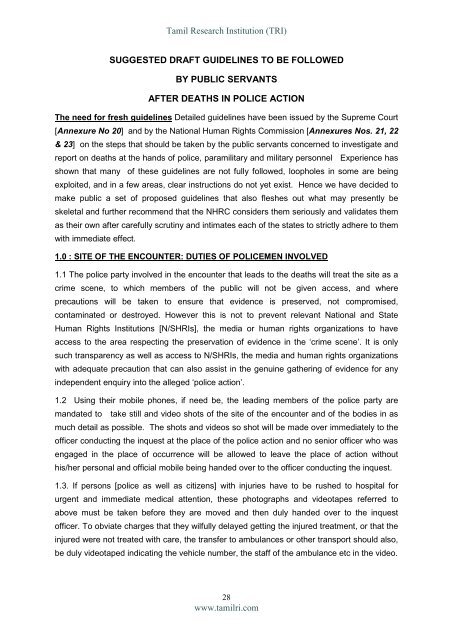Semmaram Encounter Killings Fact Finding Report2
You also want an ePaper? Increase the reach of your titles
YUMPU automatically turns print PDFs into web optimized ePapers that Google loves.
Tamil Research Institution (TRI)<br />
SUGGESTED DRAFT GUIDELINES TO BE FOLLOWED<br />
BY PUBLIC SERVANTS<br />
AFTER DEATHS IN POLICE ACTION<br />
The need for fresh guidelines Detailed guidelines have been issued by the Supreme Court<br />
[Annexure No 20] and by the National Human Rights Commission [Annexures Nos. 21, 22<br />
& 23] on the steps that should be taken by the public servants concerned to investigate and<br />
report on deaths at the hands of police, paramilitary and military personnel Experience has<br />
shown that many of these guidelines are not fully followed, loopholes in some are being<br />
exploited, and in a few areas, clear instructions do not yet exist. Hence we have decided to<br />
make public a set of proposed guidelines that also fleshes out what may presently be<br />
skeletal and further recommend that the NHRC considers them seriously and validates them<br />
as their own after carefully scrutiny and intimates each of the states to strictly adhere to them<br />
with immediate effect.<br />
1.0 : SITE OF THE ENCOUNTER: DUTIES OF POLICEMEN INVOLVED<br />
1.1 The police party involved in the encounter that leads to the deaths will treat the site as a<br />
crime scene, to which members of the public will not be given access, and where<br />
precautions will be taken to ensure that evidence is preserved, not compromised,<br />
contaminated or destroyed. However this is not to prevent relevant National and State<br />
Human Rights Institutions [N/SHRIs], the media or human rights organizations to have<br />
access to the area respecting the preservation of evidence in the ‘crime scene’. It is only<br />
such transparency as well as access to N/SHRIs, the media and human rights organizations<br />
with adequate precaution that can also assist in the genuine gathering of evidence for any<br />
independent enquiry into the alleged ‘police action’.<br />
1.2 Using their mobile phones, if need be, the leading members of the police party are<br />
mandated to take still and video shots of the site of the encounter and of the bodies in as<br />
much detail as possible. The shots and videos so shot will be made over immediately to the<br />
officer conducting the inquest at the place of the police action and no senior officer who was<br />
engaged in the place of occurrence will be allowed to leave the place of action without<br />
his/her personal and official mobile being handed over to the officer conducting the inquest.<br />
1.3. If persons [police as well as citizens] with injuries have to be rushed to hospital for<br />
urgent and immediate medical attention, these photographs and videotapes referred to<br />
above must be taken before they are moved and then duly handed over to the inquest<br />
officer. To obviate charges that they wilfully delayed getting the injured treatment, or that the<br />
injured were not treated with care, the transfer to ambulances or other transport should also,<br />
be duly videotaped indicating the vehicle number, the staff of the ambulance etc in the video.<br />
28<br />
www.tamilri.com


















